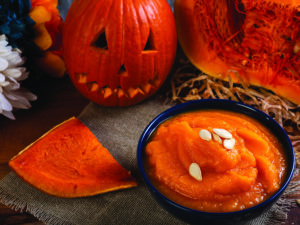Between the flavored lattes, donuts and farm markets, it’s pretty easy to track down pumpkin and pumpkin flavored food this time of year.
But, that get’s a lot tougher after Halloween to say nothing of the spring and summer months.
Now’s the time to preserve fresh pumpkin for the rest of year.
Pumpkin puree, which can be used in a variety of recipes thought out the year, is low in fat and calories, and a good source of fiber, vitamins, minerals, and antioxidants. 
Its high levels of beta carotene offer protection against cancer, heart disease and degenerative diseases. With a ready stash in your freezer, you’re a big step ahead in preparation.
According to “Homestead and Chill” blogger Deanna Talerico, it’s very important to know the difference between pumpkin puree and pumpkin pie filling.
“Pumpkin puree is just plain pumpkin (and/or squash) and is therefore more mild, earthy, and naturally semi-sweet. It’s ready to use in wide variety of sweet or savory pumpkin recipes,” She writes. “On the other hand, pumpkin pie filling has added sugar and spices, so it has far more limited uses than pumpkin puree.
For instance, you would not want to accidentally use pumpkin pie filling in our roasted pumpkin chili recipe.”
To get from whole pumpkin to puree, you can take a few different paths.
Some prefer to steam it on a stovetop, while others will slow cook large pieces in a crock pot to soften the flesh and loosen the pumpkins outer shell.
But Talerico’s choice is to roast them in the oven.
“By roasting food at 400 degrees F or higher, a magical little thing called caramelization happens,” she says.
She places pumpkin halves cut side down on a baking sheet lined with parchment paper at 400 degrees F for about 45 to 50 minutes, or until they are very tender when poked with a fork or knife.
Larger pumpkins may take longer.“Keeping them face down traps in steam, helping the pumpkins retain moisture, cook faster, and peel more easily,” she says.
She advises cutting a few slits in the skin to allow steam out and help the process along.
Once the flesh is soft and the skins are wrinkled, remove the pumpkins from the oven and let them sit until you can safely handle them.
If the skin isn’t pealing off easily, use a spoon to scoop the cooked pumpkin out.
Use a blender or food processor to blend until smooth.
If you’re using the puree right away, it can last about a week in refrigeration, otherwise, use an airtight freezer-safe container to freeze.
“Sustainable Cooks” blogger Sarah Cook recommends freezing the pumpkin in amounts you plan to use upon defrosting. A quart freezer bag of pumpkin will replace a 15-ounce can of puree from the store.
For smaller needs, she freezes puree in ice cube trays and then transfers the cubes to freezer bags.
Once frozen and stored, pumpkin puree stays good for up to a year in the freezer, though the texture and quality will be best if used within a few months, Talerico said.



